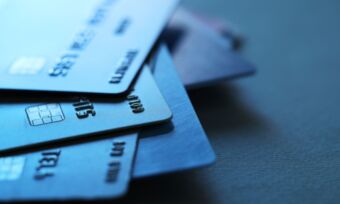At what age should I give my child a debit card?

Letting kids spend money is one of the most important financial lessons in life. While coins and a piggy bank are a great place to start, the reality is, cash is no longer king. The future is digital and sooner or later, our kids will need to learn how to navigate it.
They watch us tap our phones and cards at the checkout, so naturally, they want to tap too. But when is the right time to make the switch from physical money to a debit card?
Like many parenting decisions, the right age to introduce a debit card depends on your child, your family’s lifestyle and your parenting style.
What’s important is to have a plan. The last thing you want is for your child to learn about spending for the first time when they turn 18 with a credit card in hand.
Card readiness checklist for kids
This is a handy checklist to help you weigh up when you might want to give your child a debit card or a pocket money app.
Financial understanding
- Understands the concept of money (earning, saving, spending).
- Can differentiate between needs and wants.
- Is capable of budgeting for short-term goals (or wants to learn).
- Understands that digital money is real money.
Behavioural readiness
- Demonstrates responsibility with physical money.
- Can follow through on chores or tasks.
- Is open to discussing purchases and learning from mistakes.
- Can handle minor setbacks (e.g. running out of money!).
Family logistics
- You’re comfortable letting your child manage their money electronically (with your help).
- You’ve discussed any family rules around spending and saving.
- You’re okay to monitor transactions and guide decision-making.
- You’ve read the fine print, considered any fees and whether it meets your family needs.
What age can kids get a bank account with a debit card?
Many banks offer transaction accounts for kids, but access to a debit card is often restricted until they’re in their teens.
CommBank was one of the first to break the mould, offering debit cards from age nine. Westpac recently lowered its minimum age to eight. NAB and ANZ still hold out until ages 14 and 12 respectively.
Just to note – credit cards are off limits until they turn 18.
← Mobile/tablet users, scroll sideways to view full table →
| Big four bank kids’ transaction accounts |
|||
|---|---|---|---|
| Min age to open |
Min age for debit card |
Monthly fees |
|
| Commbank Smart Access for Youth |
0 | 9 | $0 |
| Westpac Choice Youth |
0 | 8 | $0 |
| NAB Classic |
0 | 14 | $0 |
| ANZ Access Advantage |
12 | 12 | $0 (if under 25) |
Enter pocket money apps
To fill the gap, pocket money platforms have emerged, offering kids as young as five access to digital money via pre-paid debit cards. These apps are designed to help kids earn money through chores, save for goals and spend responsibly – all under parental supervision.
Here’s a quick comparison:
← Mobile/tablet users, scroll sideways to view full table →
| App | Min Age |
Card Access |
Cost (Annual) |
|---|---|---|---|
| Spriggy | 6 | Yes | $60 (1 child), $78 (family) |
| Kit | 5 | Yes | $30 (1 child), $50 (family) – free for Commbank Yello customers |
| Flx | 6 | Yes | $25 per account |
These apps typically offer features such as:
- chore tracking;
- pocket money transfers;
- real-time spend notifications;
- transaction history; and
- spend limits.
Do kids need their own device to have a pocket money app?
Not necessarily. Many parents manage the app from their own phone, but it’s worth thinking through the logistics before signing up, because for some families it could cause more grief than it’s worth.
Are these pocket money cards as functional as a standard debit card?
Not typically. For example:
- Spriggy restricts ATM withdrawals until age 13.
- Spriggy won’t let you add the card to a mobile wallet until age 13.
- Both Kit and Spriggy have some restrictions on who you can transfer to.
- No opportunity to earn interest on Flx or Spriggy, although Kit will let you transfer to a linked CommBank Youth Saver account.
The verdict?
I’ve tested out all three of the pocket money apps, plus a couple of the more traditional bank accounts, and while my kids are a bit miffed at why they have to switch banks so often, the experience has opened up some money conversations we might not have otherwise had.
My kids love the fact they can tap their card at the shops, and I love the fact I can go through their list of transactions to show them in black and white why they’re flat broke—something a lost $20 note can’t teach.
It also motivates my kids into finally getting some chores done around the house.
However, every family is different and it’s important to remember there is no one way to teach your kid about digital money, or one right time to start.
If and when you do decide to give your child a card, make sure you compare the options and take your kid along for the journey. While they might want to choose the option with the greatest range of coloured debit cards or the one their friend has, it’s another opportunity to teach them the merits of looking beyond what’s fashionable and consider what’s functional.
Traditional bank accounts can be a good option for older kids or parents who don’t want the frills that come with a pre-paid pocket money app. They’re also a good fee-free option.
While the traditional kids bank accounts have less of a focus on chores and pocket money, they do offer kids the option of housing a bank account and a savings account side-by-side, which puts the concept of earning interest front of mind.
Finally, read the fine print
Whether you’re opening up a kids bank account, a pre-paid pocket money app or a savings account, make sure you read the fine print with your child. As boring as it’s likely to be for both you and your kids, it’s an invaluable habit to get into.
This article was reviewed by our Editor-in-Chief Nina Rinella before it was updated, as part of our fact-checking process.

As one of Australia’s leading financial and political commentators, Sally’s role at Canstar is to help Australians make better financial decisions.
As Canstar’s spokesperson, Sally provides her insights daily on trends and changes in the personal finance sector, translating often-complicated topics to help people understand how they might be impacted. She also helps identify and advocate for excellence in banking, insurance, energy and other key financial services sectors.
Sally is passionate about advancing financial literacy in Australia and is committed to helping prevent financial scams through greater awareness of new and emerging threats and by advocating for stronger consumer protections.
Sally’s diverse experience includes working across all levels of government in Australia, most notably for the country’s first female Prime Minister, the Hon. Julia Gillard. During this time, Sally worked on three Federal Budgets targeted at easing the cost of living and led the Australian Government communications team at multinational finance forums such as the G20 and APEC.
Sally is regularly interviewed by many of Australia’s leading print, online and broadcast media including Nine News, 7 News, 10 News First, The Australian Financial Review, The Australian, SMH, The Age, Daily Telegraph, The Courier Mail, Herald Sun, 7.30 report, Sunrise, TODAY, ABC Radio, ABC News, 2GB Money News, news.com.au, Domain.com.au, realestate.com.au, Yahoo! Finance.
She is also an expert speaker at leading events including the AFR Property Summit. You can follow Sally on LinkedIn.





